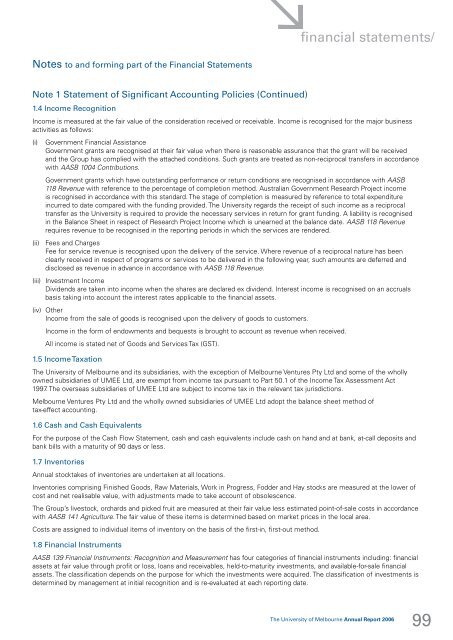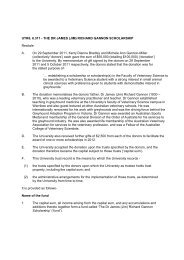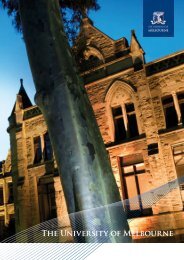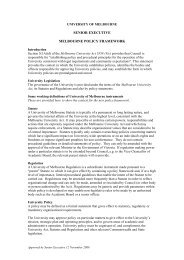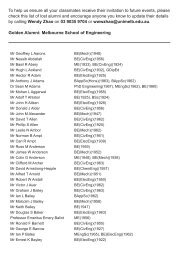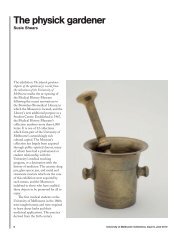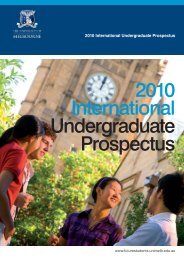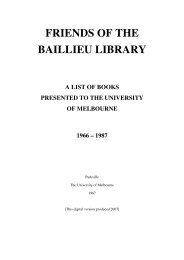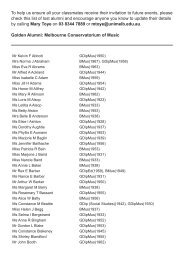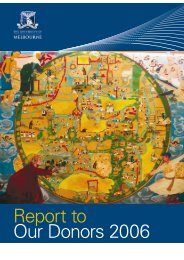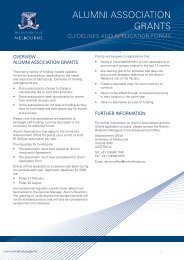annual report/2006 - University of Melbourne
annual report/2006 - University of Melbourne
annual report/2006 - University of Melbourne
Create successful ePaper yourself
Turn your PDF publications into a flip-book with our unique Google optimized e-Paper software.
financial statements/<br />
Notes to and forming part <strong>of</strong> the Financial Statements<br />
Note 1 Statement <strong>of</strong> Significant Accounting Policies (Continued)<br />
1.4 Income Recognition<br />
Income is measured at the fair value <strong>of</strong> the consideration received or receivable. Income is recognised for the major business<br />
activities as follows:<br />
(i) Government Financial Assistance<br />
Government grants are recognised at their fair value when there is reasonable assurance that the grant will be received<br />
and the Group has complied with the attached conditions. Such grants are treated as non-reciprocal transfers in accordance<br />
with AASB 1004 Contributions.<br />
Government grants which have outstanding performance or return conditions are recognised in accordance with AASB<br />
118 Revenue with reference to the percentage <strong>of</strong> completion method. Australian Government Research Project income<br />
is recognised in accordance with this standard. The stage <strong>of</strong> completion is measured by reference to total expenditure<br />
incurred to date compared with the funding provided. The <strong>University</strong> regards the receipt <strong>of</strong> such income as a reciprocal<br />
transfer as the <strong>University</strong> is required to provide the necessary services in return for grant funding. A liability is recognised<br />
in the Balance Sheet in respect <strong>of</strong> Research Project Income which is unearned at the balance date. AASB 118 Revenue<br />
requires revenue to be recognised in the <strong>report</strong>ing periods in which the services are rendered.<br />
(ii) Fees and Charges<br />
Fee for service revenue is recognised upon the delivery <strong>of</strong> the service. Where revenue <strong>of</strong> a reciprocal nature has been<br />
clearly received in respect <strong>of</strong> programs or services to be delivered in the following year, such amounts are deferred and<br />
disclosed as revenue in advance in accordance with AASB 118 Revenue.<br />
(iii) Investment Income<br />
Dividends are taken into income when the shares are declared ex dividend. Interest income is recognised on an accruals<br />
basis taking into account the interest rates applicable to the financial assets.<br />
(iv) Other<br />
Income from the sale <strong>of</strong> goods is recognised upon the delivery <strong>of</strong> goods to customers.<br />
Income in the form <strong>of</strong> endowments and bequests is brought to account as revenue when received.<br />
All income is stated net <strong>of</strong> Goods and Services Tax (GST).<br />
1.5 Income Taxation<br />
The <strong>University</strong> <strong>of</strong> <strong>Melbourne</strong> and its subsidiaries, with the exception <strong>of</strong> <strong>Melbourne</strong> Ventures Pty Ltd and some <strong>of</strong> the wholly<br />
owned subsidiaries <strong>of</strong> UMEE Ltd, are exempt from income tax pursuant to Part 50.1 <strong>of</strong> the Income Tax Assessment Act<br />
1997. The overseas subsidiaries <strong>of</strong> UMEE Ltd are subject to income tax in the relevant tax jurisdictions.<br />
<strong>Melbourne</strong> Ventures Pty Ltd and the wholly owned subsidiaries <strong>of</strong> UMEE Ltd adopt the balance sheet method <strong>of</strong><br />
tax-effect accounting.<br />
1.6 Cash and Cash Equivalents<br />
For the purpose <strong>of</strong> the Cash Flow Statement, cash and cash equivalents include cash on hand and at bank, at-call deposits and<br />
bank bills with a maturity <strong>of</strong> 90 days or less.<br />
1.7 Inventories<br />
Annual stocktakes <strong>of</strong> inventories are undertaken at all locations.<br />
Inventories comprising Finished Goods, Raw Materials, Work in Progress, Fodder and Hay stocks are measured at the lower <strong>of</strong><br />
cost and net realisable value, with adjustments made to take account <strong>of</strong> obsolescence.<br />
The Group’s livestock, orchards and picked fruit are measured at their fair value less estimated point-<strong>of</strong>-sale costs in accordance<br />
with AASB 141 Agriculture. The fair value <strong>of</strong> these items is determined based on market prices in the local area.<br />
Costs are assigned to individual items <strong>of</strong> inventory on the basis <strong>of</strong> the first-in, first-out method.<br />
1.8 Financial Instruments<br />
AASB 139 Financial Instruments: Recognition and Measurement has four categories <strong>of</strong> financial instruments including: financial<br />
assets at fair value through pr<strong>of</strong>it or loss, loans and receivables, held-to-maturity investments, and available-for-sale financial<br />
assets. The classification depends on the purpose for which the investments were acquired. The classification <strong>of</strong> investments is<br />
determined by management at initial recognition and is re-evaluated at each <strong>report</strong>ing date.<br />
The <strong>University</strong> <strong>of</strong> <strong>Melbourne</strong> Annual Report <strong>2006</strong><br />
99


